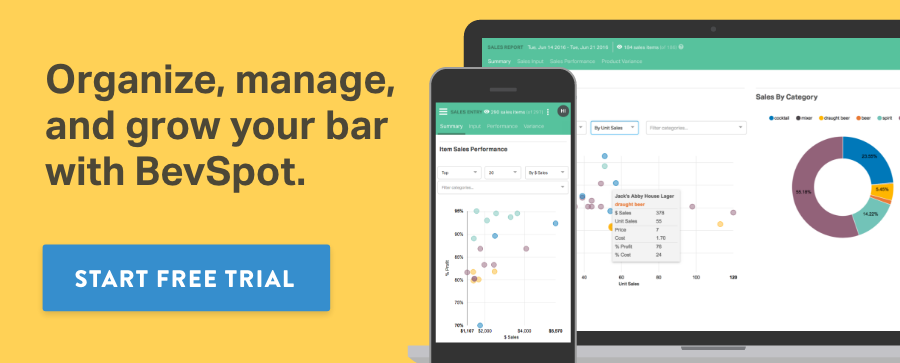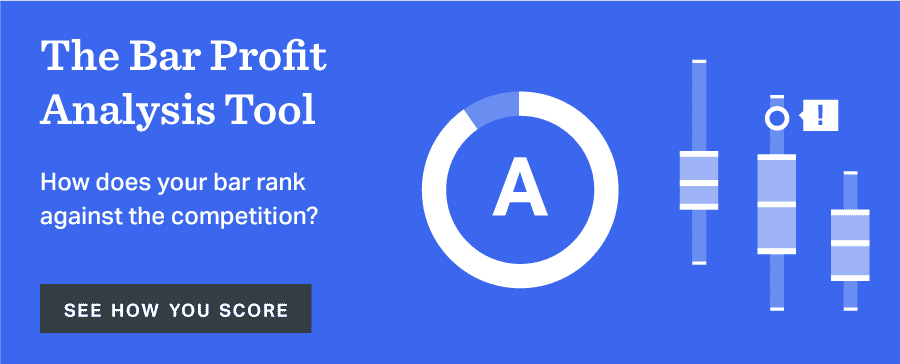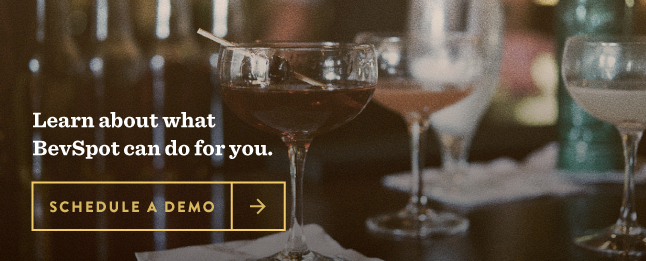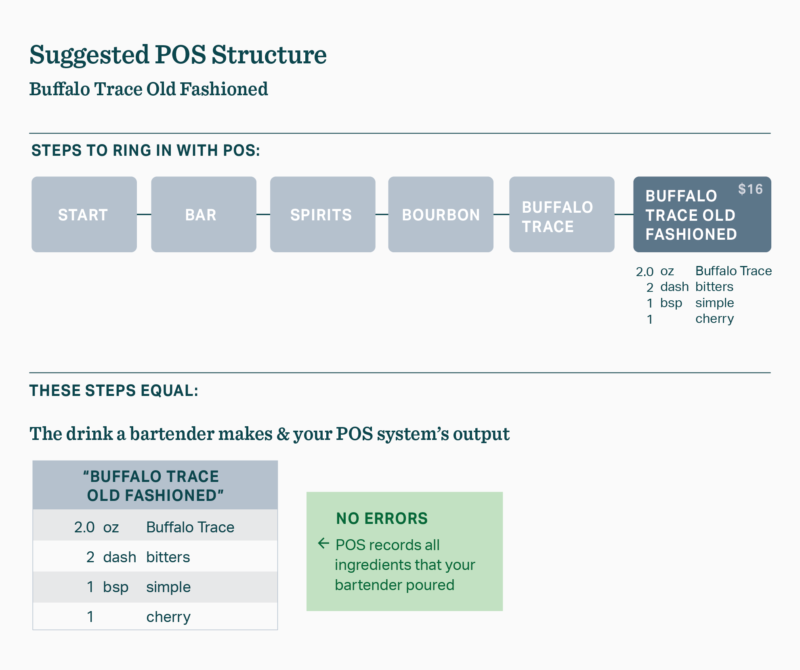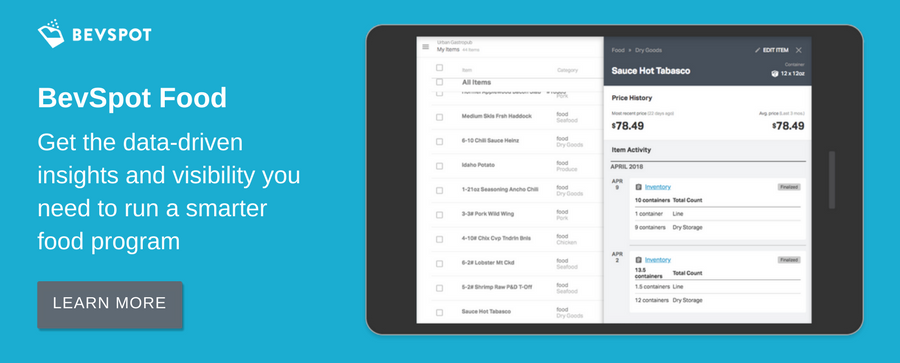Finding Profits in Your POS Reports
Show me the money!
That should be your battle cry when looking at your point of sale (POS) system. Providing it’s structured properly, your POS reports should offer insights into not only the sales and profitability of your bar or restaurant, but the overall operational performance of your business.
POS systems are an investment, and they can be costly to replace. These days, many establishments own a great piece of POS technology, but often it’s only being used as a cash register and a way for staff to clock in and out.
Even in the older machines, there’s good data hidden inside—you just have to know how to find it. So remember this: It’s rarely the resources that cause businesses to fail; it’s the lack of resourcefulness.
Besides the standard sales reports and product mixes that most professionals tend to use, there are other data points you’ll want to extract from your POS in order to measure performance and set up what are known as key performance indicators, or KPIs.
Let’s look at some KPIs that can have a real impact on your bar’s profitability.
Be More Strategic
Not all sections in your restaurant are created equal, nor are your staff members. The people on your team have unique strengths and weaknesses, and, as a leader, it’s your duty to place them in positions that maximize their strengths and minimize their weaknesses.
Perhaps you have a bartender who is extremely dynamic and interactive working the main bar, but when you staff them on the service bar they seem to crash. Or maybe you have a server who is exceptional at delighting your guests, and they’re capable of maintaining service standards like pre-busing and running food until they take on a few too many tables. This is when your staff start getting in the weeds and service starts to unwind.
Most bar managers and owners try to be fair and let their team work the stations they want, giving them more tables than most can really handle and, in general, doing things that make it easier for the staff and for the manager.
But your restaurant or bar will never succeed if you allow your team to dictate how the shift is run. It’s a classic question in hospitality: “Do you run your team, or does your team run you?”
There’s one simple way to identify optimal staff placement—through the data in your POS.
The Guest Check Average
A great way to eliminate any argument around sections is to assign them based on guest check average. This takes the decision out of your hands, from being a personal one to a performance-based one.
Since we know that not all sections are created equal, wouldn’t it make sense to put your top performers (salespeople) in your best sections? Your POS system can easily give you the data you need to rank your team from the highest guest check average to the lowest.
Use this list of data as a way to schedule and assign stations. It can also serve as a great internal motivator. Winners like to win, and giving your staff this kind of KPI can encourage them to improve their skills. Of course, you might have employees who struggle with this type of performance-based structure. The best thing you can do for them (and your business) is to encourage and offer training, but if all else fails, replace them.
Most modern POS systems can also run employee productivity reports that will show you guest check averages alongside average turn time for each ticket, plus any voids. Which brings us to our next KPI.
Comps and Voids
Mistakes cost money. Having a waste or spill sheet in your kitchen or bar is imperative to managing costs, but so is looking at your comp and void reports. Now, on the surface of these reports, things might appear fine. You’ll have to dig a little deeper to find the real value.
If you want better results, the key is to ask yourself better quality questions. Why are these mistakes happening? Is there a pattern or trend that can be identified? Is there a certain employee who always seems to be involved? Comps and voids, like waste, are a red flag highlighting the real problems within your business.
Margins are notoriously thin in the restaurant and bar industry, and losing 1-2% due to mistakes is irresponsible management. Sometimes, you just need to do a little detective work to uncover the truth in the data.
Sales By the Hour
Smart bar operators know that the cycle of business comes in peaks and valleys. Your sales periods also have an ebb and flow to them. Use the data in your POS system to schedule smarter.
If, based on the numbers, your dinner rush doesn’t typically hit until 7:00 p.m., why would you want to bring in three extra servers or bartenders at 4:00 p.m.? If you’re trying to give your staff more hours, great, but what affect is this having on your business costs?
Your Customer Database
Modern POS systems are adept in collecting information about your customers for marketing purposes. Most will gather the basic information like guest name and email. Some, like the Toast POS system, take it even further by collecting the number of times a guest has been to your restaurant or bar plus the amount of money they spent.
With this kind of data, you can customize a loyalty program and reward those guests who frequent and spend the most money at your business. It’s easy to set up a customer email marketing campaign on a service like MailChimp. Then, you can market directly to your guests.
It’s far better to reward loyalty in current guests than to try to attract new guests with discounts. When you show people you appreciate them, you’ll go beyond loyalty and start to create raving fans.
This, of course, is just scratching the surface of the data you can mine from your POS reports system. We’ll highlight some other KPIs to target in future articles.
Most hospitality professionals are not tech experts. We usually enter into the restaurant and bar business because of our love for people.
POS and bar management software companies today understand that, and they’re designing systems that are easy to use and can help you discover what’s really going on inside your operation.
Unsuccessful bars and restaurants resist adapting to the world around them. The successful ones understand that change and adaptability—especially in this industry—are just part of a business’s natural evolution. Now there’s technology to help you do that.
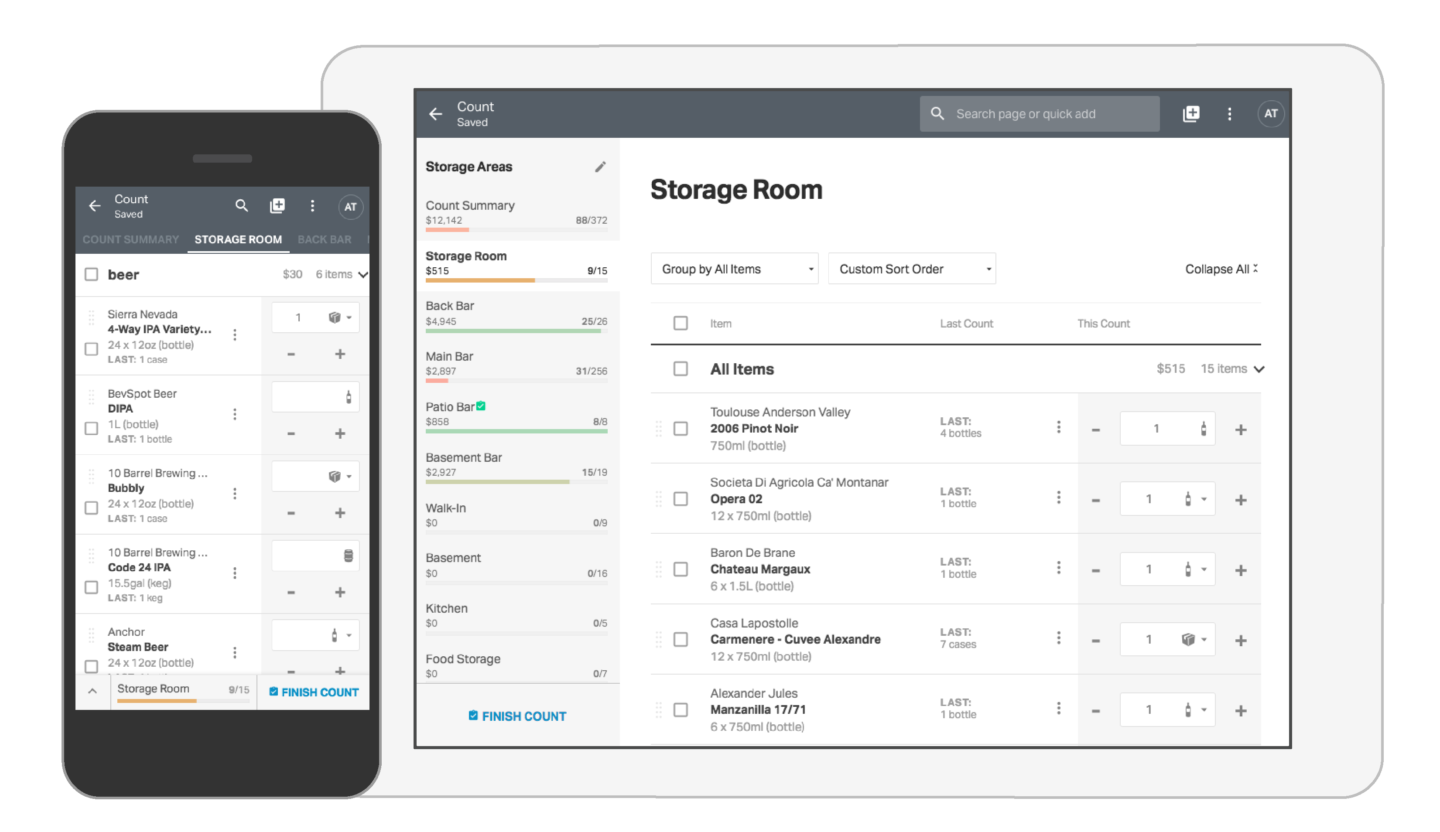
Schedule 15mins to chat with a product specialist
Start a FREE Trial Today! BevSpot offers full product education and account setup for all customers! No card Information needed!
Food and Wine Pairing For Your Bar: The Basics
Wine has a natural affinity for food that cannot be matched by that of any other beverage.
And producing a great food and wine pairing requires a fundamental understanding of both.
With this in mind, when designing a wine list for your beverage program, it’s essential to make selections that are both food-friendly and, of course, complement your bar or restaurant’s specific cuisine. Depending on your establishment type, including wine pairings that compliment the goals of the kitchen will likely be part of your successful drink menu.
The basic rules of food and wine pairing are generally straightforward. By letting the elementary rules act as your guide, you should discover true harmony, no matter how seemingly difficult the pairing challenge.
Let’s take a look at a few of these guidelines.
The Weight and Power of Wine
One of the first, and perhaps most crucial, pairing aspects to consider is weight. Start by examining the relative weight and power of a wine and a dish. A heavy dish will overwhelm a light wine, just like a heavy wine will drown out a light dish.
The whole point, of course, in pairing food and wine is to make each product taste better. If you can’t taste one because the other is overpowering it, you’re defeating the purpose. Heavy and robust dishes are best suited with heavy and robust wines, and conversely, light and delicate dishes work best when paired with light and delicate wines.
The Nuance of Wine
Another key guideline to consider when pairing food and wine is nuance.
It’s important to experience the final product of a dish before making a wine selection. Pair the wine not only with the protein, but also the sauce and the additional accompaniments.
It’s also smart to consider the way in which the protein is prepared—If you’re looking at a fish dish, is it sautéed or grilled, poached or raw? If it’s beef you’re considering, is it grilled, rare or well done?
A good red wine and meat pairing is significantly influenced by cooking style and fat content. If a steak is cooked well done, or close to it, most of the fat will have been cooked out and tannins won’t have the fat to cling to, so they won’t be absorbed in the same way they would be with a nicely marbled and less-cooked preparation.
Acid and tannins are the key elements in contrasting fat in a dish—Acid cuts through the fat and the tannins stand up to it.
The Key to Mirroring
One of the easiest ways to create a successful food and wine pairing is through mirroring. This involves pairing mutual characteristics of the dish and the wine.
If you have a peppery dish, for example, you may want to emphasize the spicy, peppery qualities and choose a zinfandel or a northern Rhone Syrah. Perhaps you’re looking to pair a wine with butter-poached lobster; in this case, a natural choice would be a rich, buttery Napa Valley Chardonnay. Another “like with like” pairing could be a white wine with a touch of green in it like an Albarinio or Sancerre, or one of a few Greek wines with green foods, such as salads or vegetables.
Let’s look at a few additional guidelines and helpful memorable devices to consider when thinking about the fundamentals food and wine pairing.
Beat the Heat With Sweet
Spicy dishes can be tricky to pair wine with because the spiciness isn’t something we taste—it’s something we feel.
The best option for spicy foods is to match them with a slightly sweet wine. The main reason for this is that sweet wines typically have a lower ABV. Alcohol makes spiciness even spicier, so unless you want your guests’ mouths on fire, pairing these dishes with a lower ABV wine is better.
The sweetness in the wine will tame the heat of the dish and bring out more of its flavor. Since spicy dishes irritate the surface of your tongue, and wine tannins can also irritate the surface of your mouth and cause a sense of dryness on the palate, a pairing of this nature will actually make the food hotter and the wine more tannic. So basically, you’ll probably want to steer clear of five-alarm chili with a heavy and tannic Cabernet Sauvignon.
If It Grows Together It Goes Together
Wine and food roots share the same terroir. If you’re serving a regional dish, why not pair a wine from the same region? They’re made to go together. The same principle is generally true for matching ethnicity of food and wine.
If the Food is Smoked, Bring on the Oak
Smoked meats and barbecue pair best with red wines that are full-bodied and heavily oaked.
We hope these fundamental pairing guidelines help you create a successful food and wine pairing for your bar. But do remember: They’re merely guidelines, not hard and fast rules. No two people experience aroma and taste the same way. Each person’s threshold for sweetness, heat or spice, saltiness and bitterness is different. So too are the perceptions of how these flavors react on individual palates.
The truth about food and wine pairing is that most wines go with most foods. Have fun with your pairings, enjoy them and, most importantly, try not to take your pairings too technically or seriously.
For more tips on running a successful beverage program, subscribe to the blog, below.
Need some help with effectively pricing the wine in your beverage program? Let our free drink pricing calculator do the work for you.
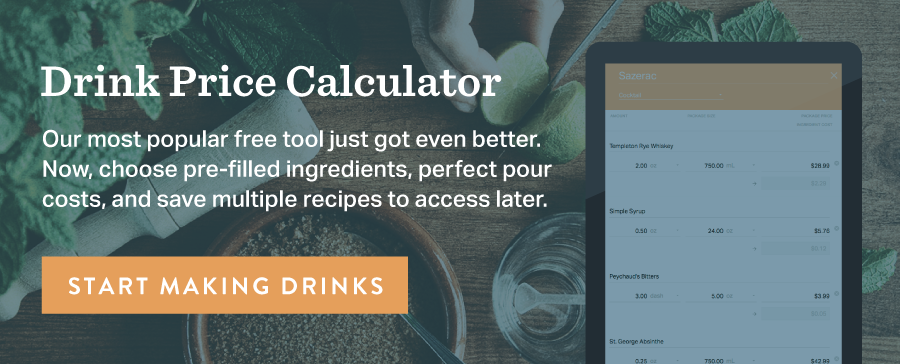
Creativity and Data: How to Craft Smart Cocktails
Thinking strategically is typically seen as an anti-creativity move. But it doesn’t have to be.
The bar and restaurant industry is continuing to evolve with the help of great technology. Whether it be reservation software, POS systems, staff scheduling tools or beverage management software, these platforms exist to help you get back to the parts of the job you love—the hospitality, the people, and the creativity. In a world of craft cocktails, where artistic expression is highly celebrated, it can be tempting to cater to your every whim when thinking of new ideas for your menu.
However, balancing this with the reality of your business is critical. As stifling it may seem, collecting your bar’s sales data on beverage management software can be that bridge to help you make smart decisions when attacking new drink ideas.
Let’s take a look at how to do that.
Laying Out the Canvas
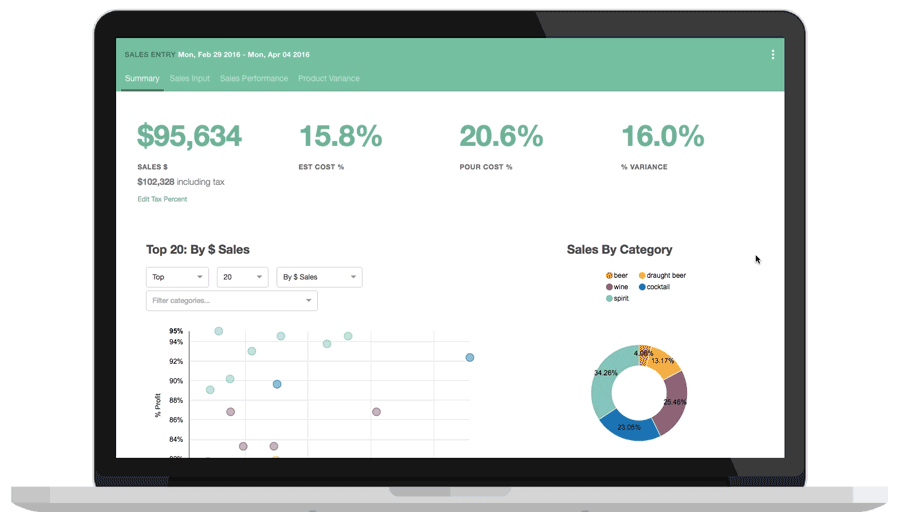
So, you’re thinking about making a new cocktail. Where should you start? Looking at a sales summary from your beverage management software or pulling sales reports from your POS system and comparing them to your drink pricing sheets is a good way to understand how much profit each drink is bringing in for you.
When you do this, you can see which spirits are performing well and which aren’t. This information can help narrow down the base spirit you should be building your new creation around, whether it be making special craft cocktails to push that struggling spirit off your shelves or a new featured cocktail that builds on a top-selling spirit.
Reading the Crowd
When looking at your sales data, you can also confirm trends in your guest’s behavior. Do your reports show that your guests are really into your tiki-style cocktails? Well, if you know the profit margin is high or confirm a good profit margin on these cocktails using tools like the drink price calculator, you could try starting a rotating tiki cocktail feature on your menu. This will allow you to continue to offer versions of this profitable drink, but also to push yourself to come up with new and inventive twists on the style.
Data’s Lasting Message
Any successful artist understands how data can be a powerful tool in service to your art. Especially if you consider the fact that you’re actually running a business with your artistic endeavors. Using technology simply enables you to do this better.
Using your bar’s data, you can intelligently channel your artistic fuel toward profitable ideas. Even if you’re a small and/or new establishment looking to stay afloat, being able to navigate in the direction that your sales data provides is key.
See how tools like BevSpot can enable you to use your data to keep your art alive and well.
Schedule 15mins to chat with a product specialist
Start a FREE Trial Today! BevSpot offers full product education and account setup for all customers! No card Information needed!
9 Bar and Restaurant Types & Their Top Selling Beverage Brands
We’ve looked at the data behind all our customers before, but not all of them are alike.
In our previous BevSpot data posts, we’ve given you a peek at the top selling beverage brands and products across the bar/restaurant industry. We’ve compared beer, wine and spirits, and broken down spirits to find the most-ordered brands.
Now, we’re taking a closer look at the types of bars and restaurants we work with.
BevSpot partners with a wide variety of establishments, ranging from nano-breweries, country clubs, wine bars and even Mexican-themed cocktail bars. And, while some of the best-selling beverages are popular in many kinds of bars and restaurants, every type of establishment has a few unique favorites that are popular with its specific customer base.
By taking a look at the highest-trafficked brands for a group of establishments, we can get a sense of how their patrons’ purchasing habits differ.
We analyzed the order data of nine different bar and restaurant types to understand how their top selling beverage brands vary.
Schedule 15mins to chat with a product specialist
Start a FREE Trial Today! BevSpot offers full product education and account setup for all customers! No card Information needed!
One, Two, Four: Opening Multiple Bar or Restaurant Locations
Congratulations—Your bar or restaurant is doing so well that opportunities to expand the business are coming at you fast.
But before you get too far ahead of yourself and sign that new lease, there are several things to take into consideration.
Running one bar or restaurant can be a challenge. When you move to two locations, you start to juggle your time, focus and tasks between the two “siblings.” Moving on to more than two can be tricky.
You need to have a few key elements in place before signing the lease on location three, four and five. Let’s take a look.
The Bench
Firstly, you’re going to need a great recruiting plan in place to fill your bench of talent. Having a successful company culture will help you attract talent, and a great training program will help your team continue to grow and engage (funny how they all work in synergy).
When businesses expand without a strong bench of talent to expand with them, they quickly realize their mistake. Most tend to take their best staff to the new location, and while, on the surface, that might seem like a good idea, many brands have felt the bitter sting of what happens when they take out too many “A” players from their best performing location. Service and standards can start to slip if the people who drive the culture are not around to reinforce the culture.
Developing a succession plan is key to recognizing potential in your current team and identifying where they might fit into the organization on a larger scale. You must have vision for this, and building a bench of all-stars is the difference between running multiple locations smoothly or becoming a firefighter and running to each location when there is an issue.
If you like working hard, spread out your team as you expand. But the successful bar and restaurant owner needs to work smart.
The Culture
The mark of any successful brand is its culture—the glue that holds a brand together. Culture is the beacon that draws in new guests and keeps current guests loyal. A good culture survives; a great culture thrives.
Look at Apple. Steve Jobs has been gone for a few years now, yet the brand continues to dominate. Why? Because of the culture he established. The look of the products, the packaging, the marketing, the image, the message are all a direct result of their culture.
Culture done correctly can help a brand stay on course when you start expanding, but it has to come from the leaders of the organization. You have to know who you are and what your company stands for. Culture, in any business, always flows down, not up. It’s a combination of your core values brought to life. As a restaurant owner, you can’t say you’re committed to local if you have no local products on your food and drink menus—this is a bad culture move.
Culture has to be authentic. As the leader, you must live it and not just talk about it. The first step to building a great culture is to figure out your company’s core values. If you don’t know what your brand stands for, how will your team or your guests know?
Your culture is also your foundation, and the strategy behind it is similar to building a house—If you have a weak foundation, when the time comes to expand, you won’t be able to build high without the risk of it all coming down upon you.
The Staff Training
You might be able to get by with an average training program at only one or two locations. But trouble will arise when consistent training is not a focus during expansion. Consistency is a major key to solid growth.
Why are chain restaurants so popular? It’s not because the food and drink is exceptional, it’s because people know they’re consistent and reliable. If you study the Human Needs Theory, you’ll discover that one of our primary needs is consistency. We want to be sure the sun will rise in the morning and that my Chipotle burrito is the same whether I get it in Los Angeles or New York City. What happens when you fail to focus on training, like Chipotle did? People get ill and your brand will take a fall. You see, even the mega chains realize the error of not focusing on solid training programs.
A great way to deliver consistent training is to plug into technology to deliver training for your team. There are many online platforms available that allow you to upload short videos and training materials to your staff management systems, to train your team in a convenient format they’re accustomed to—online. Plus, these online programs are available across a variety of devices like laptops, tablets and even smartphones.
The way you train is the way you’ll perform. Remember, training is a constant commitment to keeping skills sharp. Successful restaurants and bars know this and plan a yearly training schedule. It’s like going to the gym—you don’t attend once and never have to go back. Training never stops for the professional.
The Systems
It’s crucial to have successful systems in place to help run your businesses. You need an efficient team behind you, but you also need processes to make sure operations run smoothly. This is where technology comes in.
Today, there’s software for everything: From staff scheduling, website design, reservations management, accounting programs and project management to bar management software. These types of programs can help you manage several locations at once, giving you insight into how your businesses are operating, even if you can’t physically be there to see for yourself.
If you’re running a software program that isn’t working for you, such as an outdated POS system, it’s time to look for a better solution that you can rely on moving forward.
These platforms are generally affordable and can potentially save you hours, save you money and ensure fewer disasters at each of your locations.
The Mindset
Part of a bar or restaurant owner’s success is a great system; the rest is psychological. Moving beyond two locations requires a shift in your mindset. You’ll need to make a few adjustments to keep multiple concepts running effectively.
Trust your team. When you own one or two locations, you can easily jump in and work as needed. Now, you’re going to have to trust the team you recruited, trained and inundated with your culture. It’s show time for them, and nothing will start to drive a wedge in team moral faster than lack of trust. If you don’t trust someone on your team, find someone else who you can.
Trust is a two-way street—You want your team to trust that your vision and brand are on course, but you must be a true leader and give them the same in return.
Shift your mindset to the big picture. You need to start thinking as a brand leader and not just a restaurant or bar owner. This requires moving into the mindset of playing bigger and looking at the things that make or break a successful brand, such as marketing strategy, financials, vendor relationships and looking for more opportunity for market share. You’ll basically go from playing checkers to playing chess. Then, you can guide your company to increased sales and profits.
Making the jump from one to two to four locations isn’t easy, even with the tools to help you run a successful bar or restaurant. However, if you plan it out, seek assistance, do your research and execute your plan with the help of those you trust, you’ll have a better shot at building the brand you’ve dreamed of.
Customer Stories: HOBNOB Food + Social Exchange
HOBNOB, which just got its start this past March, is the dream establishment of its owners. Even when they opened the highly successful Candy Apple Café & Cocktails, nestled deep in downtown Jacksonville, Florida, HOBNOB was on their mind. With its global flair but local focus, the establishment has also been an integral part of bringing new culinary life to the Brooklyn neighborhood of Jacksonville.
Marlon Hall, the Bar Manager at HOBNOB, has been responsible for crafting a high-end cocktail program to feature alongside their full beer and wine program. Having managed other bars in the past, his goal was to take away the frustrations he felt managing inventory with previous pen-and-paper systems, so he could focus more on building relationships with new guests as well as overseeing the bigger picture of the new enterprise.
With BevSpot, Marlon has been able to see an 80% reduction in inventory time. He has also been able to keep his team focused on the bottom line, which is critical for a new establishment, with the tools BevSpot provided:
“[It’s] helping me not only train my staff to be better bartenders, but also to think like bar managers. So, when they’re playing around with a new cocktail, it’s not just ‘does this taste good?’, it’s ‘is this profitable for us? Will we be able to sustain getting these ingredients at a reasonable cost, and how does this help the business move forward?’”
Discover how BevSpot was able to help Marlon reach his goals and beyond.
Pour Cost, Variance and Sitting Inventory—Why They Matter
We often talk about beverage program metrics.
And, as a bar manager or beverage director, you probably know what these metrics mean, how to calculate them and the industry’s averages. But, understanding why these bar management calculations matter, and the impact they can have on your bar, is just as important.
When time is valuable, calculating and examining the numbers can be tedious. But tracking and understanding your pour cost, variance and sitting inventory is crucial for results.
Let’s take a closer look at why.
Why does pour cost matter?
Pour cost is a critical number for understanding the overall profitability of your bar. By calculating and interpreting this percentage, you can reveal inefficiencies in the management of your beverage program.
Pour cost is influenced by three things: drink costs, drink prices and product loss. If you calculate your pour cost and realize it’s above the industry standard of 20%, you can dig deeper to discover what’s driving up your beverage costs. Once you determine if it’s due to inaccurate pouring, poorly-priced ingredients or bar theft, you’ll be able to take actionable steps to reduce it.
Although occasionally over-pouring a cocktail ingredient or mispricing a drink by a dollar might not seem like a big deal, these instances can add up to create a much larger problem. By keeping tabs on your pour cost and working to reduce inefficiencies, you can save a great deal of money each year. In fact, on $500,000 in beverage sales, every 1% reduction in pour cost is an extra $5,000 back in your pocket, every year.
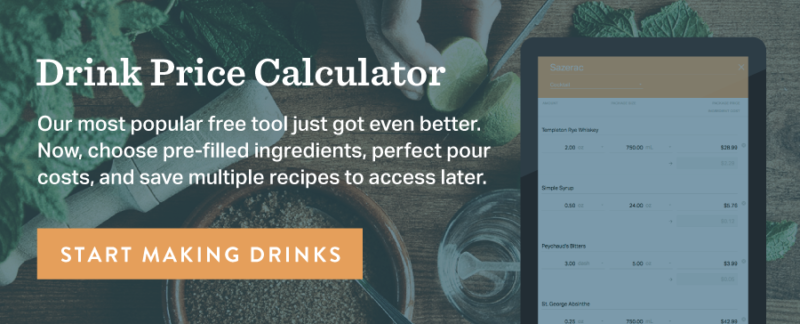
Why should you care about variance?
Variance is one of the biggest detractors from a beverage program’s profitability. It represents how much product you lost before you had a chance to sell it.
If no steps are taken to reduce it, variance can drastically reduce your bar’s profits. Computing and interpreting your variance number is essential if you want to make strategic decisions to overcome problems like over-pouring, miscounting and theft before they cut into profits too significantly.
Keep in mind, your variance also directly increases your pour cost. After you’ve calculated your anticipated shrinkage, you can factor it into your pour cost to ensure you have a cushion.
What’s the point of reducing sitting inventory?
Reducing your sitting inventory can free up cash, reduce inventory time and decrease your shrinkage.
If you funnel a lot of cash into excess inventory, you’ll decrease your available funds for other important expenses, like payroll and rent. In addition to tying up costs, surplus inventory can crowd your storage rooms and take forever to count, making it difficult to track your usage and taking time away from other important activities (like interacting with customers). More product also means increased opportunities for theft and breakage, which can significantly drive up your beverage costs.
It’s easy to overlook your sitting inventory as profitable products waiting to be sold. To run a successful establishment, make sure you’re considering its effects on your available funds, valuable time and risk of product loss.
We all know the importance of these numbers, and making sure you’re calculating and interpreting them on a regular basis is crucial. This way, you can immediately reveal inefficiencies in your beverage program and quickly address them before they cut into your profits.
Want to stay on top of these numbers without the constant work? BevSpot can give you all the data behind your bar while calculating and analyzing the numbers for you. See how it works—schedule a chat with one of our product specialists.
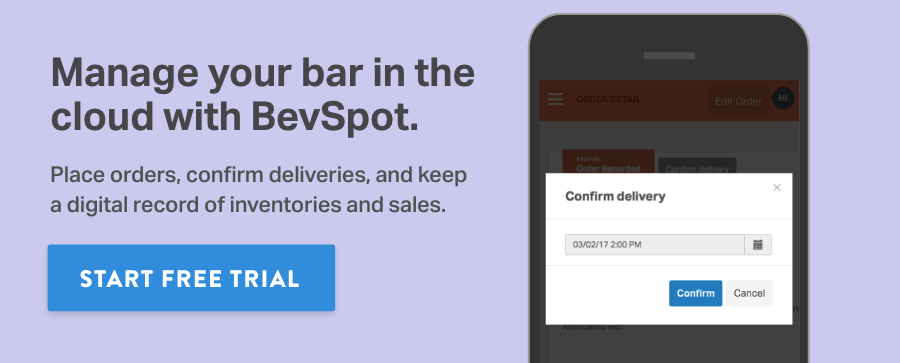
Schedule 15mins to chat with a product specialist
Start a FREE Trial Today! BevSpot offers full product education and account setup for all customers! No card Information needed!
7 Bar and Restaurant Math Equations to Boost Profitability
Improving your bar’s profitability comes down to understanding the numbers. And, for any beverage program, there are plenty to remember.
To make it easier, we’ve put together the seven essential bar math equations for running a more profitable bar or restaurant.
Bookmark it. Print it. Never forget an equation again.
1. Inventory Usage
Crucial for efficient inventory management, the inventory usage equation tells a bar manager exactly how much of each product a bar has used over a defined period of time. This equation is a crucial first step in almost every measurement of a bar’s performance.
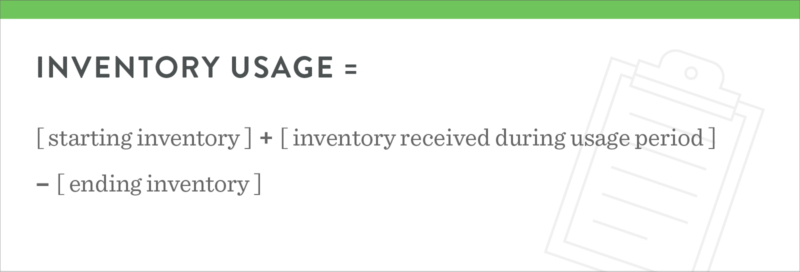
Download your free inventory spreadsheet.
2. Pour Cost (or Cost of Goods Sold)
Pour costs, also referred to as beverage costs or cost percentages, represent the percentage of cost your drinks make up compared to your resulting sales. They’re affected by drink cost, drink pricing and product loss, and they’re an essential gauge of your bar’s profitability and financial health.
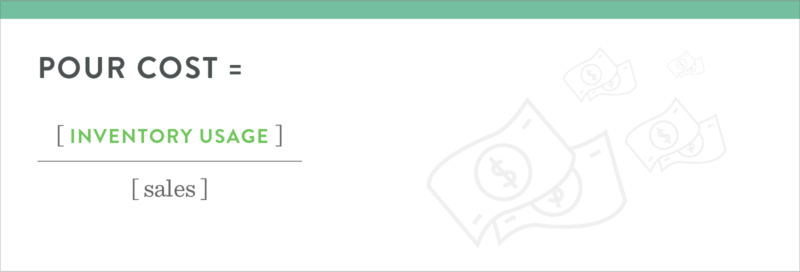
3. Variance/Loss
Variance is one of the biggest detractors of a beverage program’s profitability. It represents the difference between the amount of product sold during a given period of time and the amount of product used during that same period.
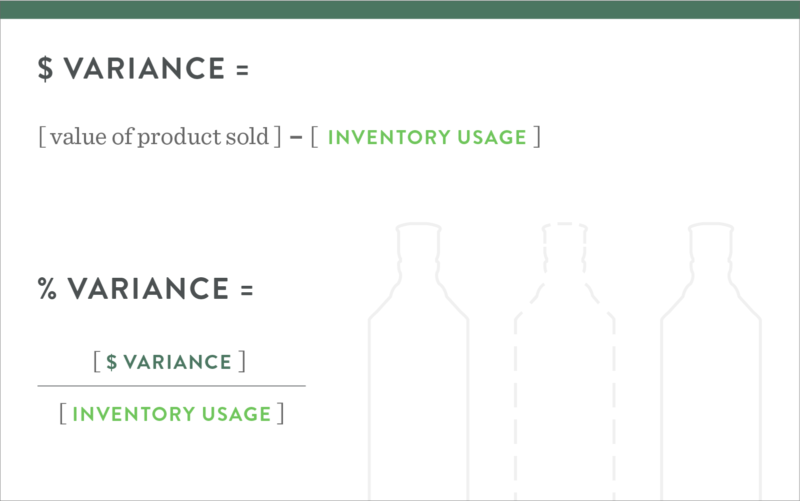
Total Beverage Costs
4. Total Cocktail Cost
The first step to pricing a cocktail is understanding how much your drink costs to make. To figure this out, you’ll need to know your drink’s ingredients, their container sizes, prices and pour sizes.
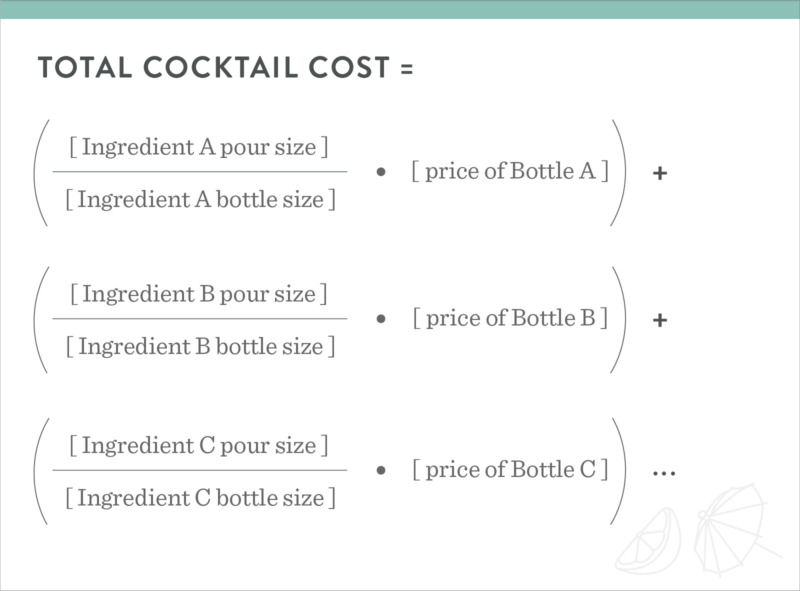
Or, let our free Drink Pricing Tool do it for you.
5. Total Draft Beer Cost
To determine how much each draft beer costs, you need to know the keg size (usually 15.5 gallons), its price and your draft pour size (usually 12 or 16oz).
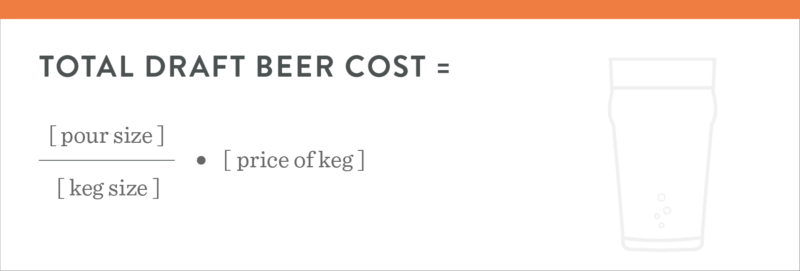
6. Total by-the-Glass Wine Cost
In order to understand how much a glass of wine costs, you’ll need to know the size of the wine bottle (usually 750ml), its price and your wine pour size (usually 5oz).
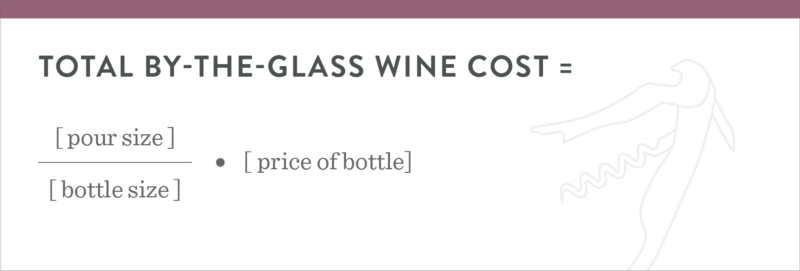
7. Drink Pricing
To price your drinks, first determine your desired cost percentage for each category (e.g. 24% for beer, 15% for spirits and 28% for wine). Then, divide this by your desired pour cost percentage. Be sure to round numbers for straightforward pricing.
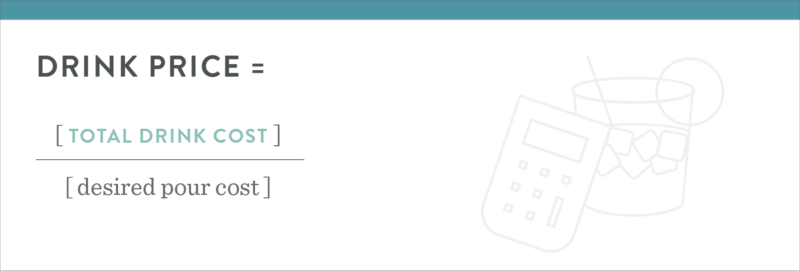
Keep in mind, your drink pricing will need to be constantly updated due to shifting product prices. To save you time and effort, we created an easy-to-use Drink Price Calculator that will quickly do all your drink pricing for you.
We know, there are too many bar management equations to keep track of. That’s why we built software to deal with all the numbers for you.
BevSpot gives you all the data behind your bar—in one place, on any device—enabling you to make smarter business decisions while also saving you time and money.
Want to see how it works? Book a demo with one of our product specialists.
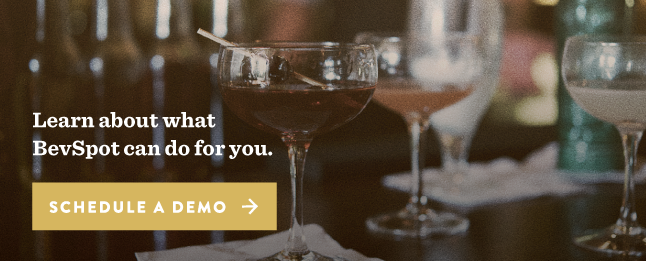
The Top-Selling Liquor Brands, Continued
The world of spirits is wide and vast.
When you’re trying to plan your bar’s roadmap through stocking the right liquor, it can be tough to navigate. Where exactly do you start? Where’s the safe beaten path, exactly? And how far can you stray from it?
We’re here to show you where our users went in their liquor checklist to hopefully give you enough context to make some smart decisions for your beverage program. There are also some interesting deviations in previous data and expectations that correlate with trends in the industry.
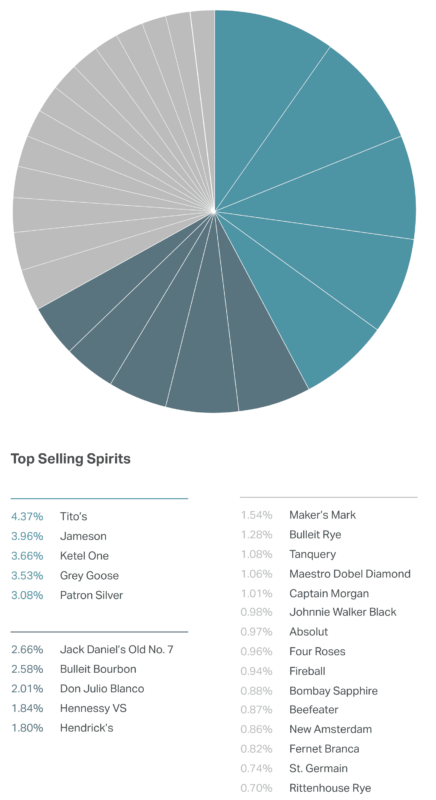
The Continuation of Craft
A popular practice when building a beverage program is centering around well-marketed spirits. Not only are these liquors aggressively marketed towards bars, but these spirits are also recognized and asked for specifically on a much more frequent basis overall by consumers.
That is reflected in the data we’ve collected, as some of the top-selling spirits prominently feature commonly known spirits by consumers, like Jameson Original and Patron Silver Tequila.
However, a surprise chart-topper is Tito’s Handmade Texas Vodka. The Austin-based distiller has established their reputation within the industry on not only the high quality of their vodka, but also its ease of use in cocktailing. One of our BevSpotters, Dylan Freehauf, a former Beverage Director at Rye Tavern, noted that the fact that this brand was able to beat out Ketel One and Grey Goose on our list demonstrates the continued trend of craft cocktailing in both bars and the ordering of bar-goers.
This trend is also supported by the odd mainstays of the list, in the forms of Fernet Branca and St. Germain. Fernet Branca, a standard industry liqueur to shoot after your shift, is commonly used in cocktails like a Toronto or Hanky Panky. St. Germain, an elderflower liqueur, is also a key ingredient in cocktails like a French Gimlet or Rob Collins.
The King of Russia
Vodka stands out prominently on our graph as well, as three of the top four selling liquors are one of our favorite combinations of water and ethanol. Vodka has always been a chart-topper in popularity since the 50’s and 60’s, but there are a couple reasons that could explain the dominance of this spirit in our customers’ orders. Besides the commonplace ordering of vodka/sodas and vodka Martinis at bars, it could also be said that vodka has arguably the easiest flavor (i.e. very little to none) to work with when concocting cocktail recipes.
Check out more industry trends for beverage programs by subscribing to our blog below. Also, let us know what else in our data stuck out to you in the comments section.
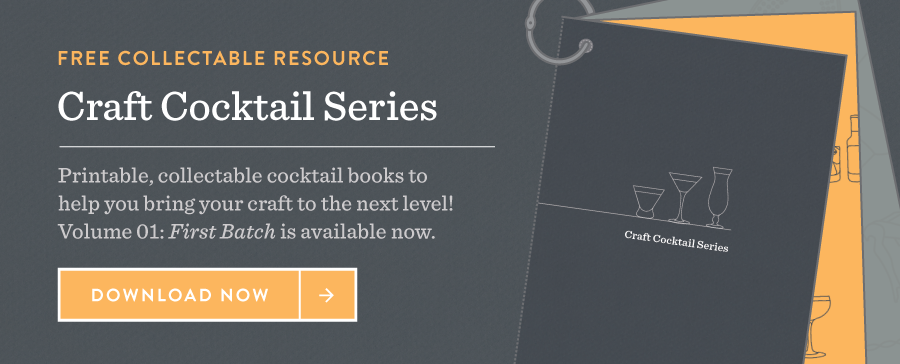
Setting Up Your POS Item Modifiers
Restaurant Software
There’s a new wave of great bar and restaurant technology making big changes in the industry. And, as a hospitality professional, these software products exist to help you run a successful business and be better at the job you love. But technology needs updating and correct structuring if it is to be both valuable and profitable, and POS systems are one of the more complex systems to deal with. There are many different ways to structure the Point of Sale (POS) item modifiers in your system. Properly setting up your POS will allow greater flexibility for your staff to upsell and provide a faster ring-in process on the floor.
However, some of these POS configurations can cause major complications when you’re trying to evaluate what you’ve actually poured and the cost of goods sold based on your sales reports.
What does that mean, exactly? Let’s make an Old Fashioned together and see.
Below, we’ve included a few common types of POS structures and the pros and cons of each.
Dependent Modifiers
This is the most common type of modifier structure in the industry.

PROS:
This dependent structure is easy to ring-in on the floor, allows servers to create drinks from any spirit variety, and requires minimal setup, since there are very few buttons to create.
This type of POS modifier structure can work for you without consequences IF you aren’t pouring additional quantity of the first selected liquor.
CONS:
It’s likely that your ‘rocks’, ‘tall’, ‘up’ or other cocktail modifiers call for extra product than just the standard pour size—and this is where things get messy. In sales reports, your Bulleit sales show up on one line—this represents how many times the ‘Bulleit’ button was hit. The ‘$Old Fash’ button shows up on a separate line, completely separate from the original spirit selection. That means, if you hit the ‘$Old Fash’ button 100 times, across several bourbons, your POS does not connect those extra ounces to the specific product that was actually poured—you cannot effectively track how much product you should be using on each individual item, making it impossible to track key metrics like variance. The data just doesn’t exist.
This can add up quickly. If you pour an extra ounce for every Cosmo, Manhattan, Martini or rocks pour, and you sell 100 of each, that’s 400 ounces of mystery—almost 16 750ml bottles—and there’s no way to tell if they left for legitimate use or walked away. The more you use these types of buttons, the more dangerous they are to your profitability.
This type of modifier structure makes pinpointing loss, over-pouring and pour costing very difficult.
Subordinate Modifiers
Pros:
This subordinate structure is easy to ring-in on the floor, allowing servers to upsell to top shelf spirits quickly, and clearly communicates with the bar what should be poured.
This type of structure is far less problematic if the cocktail buttons never appear without a liquor modifier, meaning there is no default spirit and your staff must always select what liquor to pour. If this is the case, you can accurately track pour-for-pour variance. However, your item level cost percentages will be drastically skewed. Take a look below to see how.
Cons:
This type of modifier structure creates problems when you’re trying to determine which spirits are being poured at what price points. What looks like a simple upsell button actually means a substitution, which artificially inflates your cost percentage.
Here’s an example that better explains what we mean:
When that ‘Old Fashioned’ button appears, your bartender knows to pour 2oz of Bulleit Rye (based on your house recipe). The cost percent of that item is: [cost of Bulleit + bitters + sugar] / [$12]
If the server is upselling to Buffalo Trace for a $4 price difference, that button no longer means 2oz of Bulleit. To your staff, it means NOT 2oz of Bulleit, but instead, 2oz of Buffalo Trace (which doesn’t appear in the data). You have no real way of understanding what you should or should not have poured. Furthermore, your cost percent looks like this:
[cost of Bulleit + bitters + sugar] / [$12]
And separately:
[cost of Buffalo Trace] / [$4]
This doesn’t represent what’s actually happening in terms of cost or in terms of pours. So, you won’t be able to clearly identify what you poured and at what price. Finding variance and making cost decisions will be difficult.
Working on BevSpot’s customer success team, I’ve seen hundreds of sales reports from dozens of different POS systems, at every level of data quality. And you know what? Not one has properly structured modifiers that can give correct variance and pour costing data for these variable drinks. (If anyone has experience with a POS that can handle modifiers better than what we’ve explored above, please let us know in the comments—we’d love to hear about it!)
Until we find that perfect POS, let’s take a look at our recommended method for structuring your current system to get the most accurate info.
If you’re a BevSpot user, this structure will allow you to get the best data from your POS system to use with all of our reporting features. If you’re not a BevSpot user (we think you should be!), this structure will still give you the best view into your data. Let’s check it out:
Ideal Structure:
Pros:
Setting up your POS buttons in decision trees like this, where the full detail of what is being sold is included in the sales item, offers perfect clarity into what’s being poured. You’ll be able to see a line item for the Buffalo Trace you sold at a 2oz pour in Old Fashioneds separately from the Buffalo Trace 1.5oz pour you served neat, and you’ll be able to easily specify the underlying mixers (think: bitters, vermouths and other miscellaneous ingredients) that add to the cost of the drink. This is a seamless way to perfectly track exactly what is happening with every pour you make and every dollar you bring in.
Cons:
Lots of buttons and set up; staff retraining.
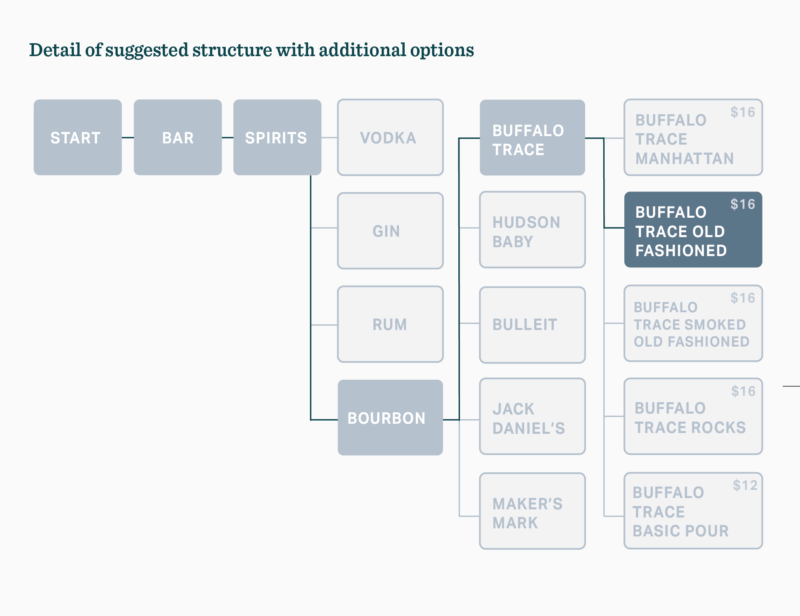
So, what do you do about it?
Your POS system may have one or any combination of these structure types. After evaluating your current setup, if you’re not happy with the information your configuration can provide, don’t fear! This doesn’t mean you need to launch a massive restructure, spending time and money talking to customer service on the help line of your POS system (which we know can be brutal). You can choose to adjust the buttons you use most frequently, or maybe just those buttons that affect your highest volume goods sold.
If you’re committed to making changes, here are some steps to follow:
Step 1:
Evaluate the size of the project:
Maybe you only have a handful of cocktails that are skewing your numbers. Look through the data you’re getting out of your POS today and prioritize what changes you can make to the greatest benefit.
Step 2:
Test on a sample of buttons where you’ve identified a problem:
Testing a restructure of a few buttons will allow you to see a couple things: does the data come through the way want it? Does this change drastically affect your operations on the floor? Changing your entire POS for perfect data won’t do you any good if your servers collapse and your bartenders have no idea what to pour. You want to make sure the changes made give you the information you need to run your business.
Step 3:
Roll out the changes:
After testing, if you’re happy with the results, it’s time to kick things off! You may have the back of house control you need to make this happen on your own, or you may need to loop in your POS company. Give your staff some education on the new process, and prepare to exist in data bliss!
We know POS structures aren’t too high on everyone’s list of favorite tasks behind the bar. That’s why we’re here to help.
If bar management tasks seem daunting, we’ve got you. With BevSpot, you’ll have an expert partner to guide you through every step, and a product that will automatically process all the math afterwards, to boot!
Schedule 15mins to chat with a product specialist
Start a FREE Trial Today! BevSpot offers full product education and account setup for all customers! No card Information needed!
Cutting Costs in Your Bar Without Cutting Corners
When business is good, everything is great in your world.
When the numbers turn bad, however, most bar owners turn to making budget cuts to make up the loss in sales. But, let’s put something out on the table right away: You cannot save your way to a profitable bar or restaurant.
As a bar or restaurant owner, do you need to be aware of your costs? Of course. Do you need to overreact and make drastic cuts when the numbers are declining? Probably not.
Just like in any business venture, irrational changes are usually not the course of action you want to take. Let’s take a look at some common economical areas and ways you can cut costs in your bar without cutting corners.
Market Your Bar
Unfortunately, marketing is one of the first areas that many restaurant and bar owners tend to put on the chopping block first. But, when business is slow, the last thing you want to do is cut back on your marketing efforts. In fact, you need to amp them up!
If radio, TV and print advertising is outside your budget, have no fear. In today’s market, all you really need is a smart phone and some Internet access to drive traffic to your business. Yes, we’re talking about social media.
There are three main platforms you need to be consistently active on (and the keyword here is consistently): Twitter, Facebook and Instagram. These three are the trinity of social media marketing. Combined, they provide a three-way of social media power that most older forms of marketing can’t even touch. If you’re proficient in the three already, make sure to expand into new social media platforms like Periscope and Snapchat.
With as little as a one-hour commitment each week, you can start driving traffic to your restaurant with a very limited budget. You can post on each platform separately, or you can use a social media management tool like Hootsuite, Buffer, Everypost or Sprout Social to help you schedule your posts for around $10 a month. These tools are all fairly easy to use and learn. Once you get the hang of it, all you need to do is spend a little time on one of your slower days and schedule all your social posts for the upcoming week.
If you really want to jump on a hot (but probably short-lived) trend, look into catching the Pokémon wave of business. If you haven’t heard of this mega trend, get your head out of the sand and study. Many bars have been lucky enough to be named a Pokémon Go Gym, which is like hitting the Powerball numbers. This basically makes your bar or restaurant a Pokémon hot spot. Where there are Pokémon, there are fans—or rather, potential customers—who want to catch them.
Get creative and think about some off-the-wall ideas like a Pokémon brewers crawl with other local businesses—a beer crawl set up to help your guests enjoy some drinks and go on the hunt for those little digital characters. Oh, and don’t sweat it if you’re not a Pokémon Gym or stop. You can buy credits that attract Pokémon to your bar or restaurant for 30 minutes (it’s called a lure module). The cost to buy a 30 minute “lure module” is only about $1. Just make sure to tie it into your social media channels and get the word out that at a certain time your place is going to lure Pokémon, and watch the fans come looking for them.
It’s being up to date with the latest digital trends, such as this one, that will help you attract more customers.
Train Your Team
Here is another area that usually suffers from the axe of cutbacks. Just like marketing, it’s really not an area you want to cut back on. Restaurants and bars get better when the people working in them become better at what they do.
How does your staff improve? Training.
When times are tough and business is slow, bringing in a consultant to do some training can be a good idea. What you can do is talk to your vendors—food and beverage distribution companies are not suffering for sales. In fact, a lot of these vendors hire outside consultants to come in and conduct seminars for customers. Shamrock Foods, Sysco, Ben E. Keith and many others hold educational workshops on topics such as food cost, hiring, marketing and suggestive selling techniques for your service team—all free of charge if you buy product from them.
Education and training doesn’t have to be in a formal class setting. Blog post like this and articles from other websites like Foodable TV Network, Modern Restaurant Management, Toast Management Blog, Liquor.com and Bar Biz Magazine all publish free content on how to improve your bar operations. Browse the Internet for a while, find a couple of blog posts or articles that could be useful for your team and print them out for distribution.
Also, take advantage of the many industry magazines available (you may even qualify for a free subscription for some) on the market like Restaurant Business, Restaurant Hospitality, Market Watch and Nightclub & Bar Magazine. These are just a few of the many available resources for training and education.
Know Your Numbers
It doesn’t make a difference how much you cut from this budget or that budget if you don’t know your costs in the first place. You must do your homework and set up your business for success, or you might be making bad decisions based on bad information.
Maybe that bone-in dry-aged pork chop on the menu is not really a money maker and it’s time to cut that from your kitchen’s inventory. How about that eight-ingredient craft cocktail that takes the team two hours just to prep for and has a beverage cost of 40%? Sure, it’s impressive. But, being on-trend without being profitable is a losing proposition. If you don’t know the cost of every item on your menu, through correct drink pricing, pour costing and understanding your sales information, your business will suffer.
Whether busy or slow, profitable or not, there are some things you must always do to be successful in this business. Always be marketing. Always be training. And always be the person who knows their costs and sales data. Follow these processes and you might not need to make any cuts at all.
For more tips on bar and restaurant management, subscribe to the blog, below.
Why Every Bar Employee Needs Bar Technology
Is your bar struggling to keep up? Here’s how technology can actually help.
It’s more difficult than ever to run a successful bar or restaurant, which brings up questions as to what you can do to get a strong competitive edge. But, the answer could be staring you in the face. Bar Technology could be the tool to get you there. Whether it be taking inventory, ordering product, managing staff, analyzing sales reports, handling reservations and even correctly pricing your drinks, technology can serve to provide you with the important data and resources to make smart decisions.
Here’s why all of your bar’s employees need technology.
The Owner
Whether you’re an owner who’s right there in the trenches with your staff or you prefer to see the business from a more hands-off, outside perspective, technology can help you get a firmer grasp of how your bar or restaurant is doing in the competitive landscape. Being able to empower your decision-making with real-time, actionable data is a tool worth investing in.
Technology can save your staff hours of time each week, cutting down your labor costs, but it can also provide you with the data you need to run a successful business. As we know, data-driven businesses can more accurately measure costs and profitability.
What if you own more than one location? Bar technology can provide you with insights into how each of your locations is performing. Make comparisons across profitability, products and staff performance. Access information in one place, from wherever you are, which can save you visits to each of your locations or phone calls with accountants.
The General Manager
A visible representation of how your business is doing, besides how full your bar is every night, can be extremely helpful and even critical for general managers. Not only that, but technology can make the day-to-day more effective, with less time spent struggling with compiling sales reports from outdated systems or communicating invoices to the accountants. These types of functions make it much easier to present results to your establishment’s owner.
By using technology, the time savings can be huge, allowing you more time actually overseeing the larger scope of the business, more time with your customers and staff members, and more time to spend on the parts of the job you love.
The Beverage Director
Imagine being able to judge product based on unbiased, comprehensive sales data rather than depending on what your sales reps tell you or what you think your customers like. That’s what the right technology is able to offer to beverage directors. Choosing product with actual profit value as well as being able to visualize the reasons for the success or failure of a product on the menu can be incredibly powerful when putting together a thriving beverage program.
And as for the painful drink pricing and pour cost calculations that are a part of every menu or new product launch, forget about them. Bar tech will do everything for you.
The Bar Manager
We understand that working with sluggish and unreliable POS systems can leave scars. But, with the right tools, bar managers won’t have to be stuck at the bar for hours on end doing menial tasks like inventory and ordering, and can be actually focused on improving the day-to-day of the bar. You can also send all your orders simultaneously without having to spend one minute on the phone with sales reps.
Bar technology can also give you critical insights into your product usage. Not sure why your variance is so high on a particular whiskey? Drill into the data and find out how much product you’re missing, what day it disappeared and how this lost product affects your sales.
Why spend hours sorting bottles in the storeroom when what you should be doing is training staff, scheduling your crew and spending important time with your favorite guests? Bar technology can save you and your team hours, helping you hit performance bonuses and deliver results to your manager.
The Bartender and The Bar Back
The impact of technology can trickle down to bartenders and bar backs as well. No longer will you be forced to waste hours of your time pulling bottles from all over the bar. You and your managers will be able to use an iPad or smartphone and simultaneously blast through counting the bottles wherever they are stored. Spend less time on inventory and more time perfecting your craft cocktail technique.
And no longer will bar managers be on your back needlessly about missing or wasted product—the right technology will make sure everything is properly accounted for.
Ultimately, as much as we preach the benefits of technology, it simply won’t be for everyone. But, for bars looking to get smart and more profitable, the right technology can help your bar build better processes for the future and gain that competitive edge to thrive where others may fail.
Want to see what BevSpot’s bar management software can do for you?
Schedule 15mins to chat with a product specialist
Start a FREE Trial Today! BevSpot offers full product education and account setup for all customers! No card Information needed!
BevSpot raises $11 million to give booze sellers better data
BevSpot, a web-based platform that helps hospitality businesses manage their alcoholic beverage programs, has raised $11 million in a Series B round led by Bain Capital Ventures.
Founded out of Boston in 2014 by a team from MIT and Harvard, BevSpot serves up a suite of mobile tools that lets its users — which include restaurants, bars, nightclubs, and hotels — manage their alcohol inventory and related invoicing. It’s also compatible with point-of-sale systems, so sales can automatically be accounted for.
About BevSpot
Manage your bar, without the headaches
Take inventory, track orders, and see sales data on any device. Instantly backed up to the cloud and accessible anywhere.
https://bevspot.com/bar-restaurant-naming/
How Much Do Bars Save With BevSpot?
Data-driven businesses have one key advantage: The ability to accurately measure costs and profitability.
When bar managers can quickly and easily see opportunities to reduce waste in their operations, they enable themselves to run more profitable operations in the long run. And in an industry where as many as 80% of bars and restaurants fail within five years, bar owners can’t afford to pass on easy opportunities to run their establishment more efficiently. One essential metric for a successful bar is your average pour cost —it directly relates to a bar’s ability to control costs and price for profitability.
By accurately calculating pour costs and comparing them to industry benchmarks, a bar manager can easily find out how much their business can improve.
At BevSpot, we provide bar owners and managers with the tools and data they need to streamline their operations, including their average pour costs. And to ensure their beverage programs succeed, our Customer Success team works with them to implement operational improvements with that data.
So, how much can we help your bar? For the answer, you could ask a few of our customers. Or, as we like to do, we could show you the data. We looked at the pour costs of all BevSpot bars to see how the numbers change as they begin to use our software.
Schedule 15mins to chat with a product specialist
Start a FREE Trial Today! BevSpot offers full product education and account setup for all customers! No card Information needed!
Tales of the Cocktail 2016 Preview
The 14th annual festival celebrating craft cocktail culture is right around the corner.
For all the lucky bartenders and industry professionals spending their time in New Orleans this week for Tales 2016, we’re incredibly jealous. It’s one of the biggest events of the year, and for those attending, there’s a lot of ground to cover. From all the exciting craft vendors showing off new products to the Moscow Mule competition, let’s get you up to speed on all the events we think you shouldn’t miss at this year’s festival.
Bitters Market
Tuesday (July 19th) to Saturday (July 23rd), 9:30am-6pm; Hotel Monteleone (Lobby)
A growing staple of the festival is the Bitters Market. With over 30 bitters makers from all over the world showcasing their products all week long, it will be a must-visit for connoisseurs and professionals alike. Some of the new brands attending this year include Bitter Girl Bitters, Hella Co. and The Apothecary Bitters Company, amongst other exciting companies.
Sustainable Spirit Awards
Wednesday (July 20th), 2pm; Hotel Monteleone (Front Steps)
This might seem like a blip in the schedule, but the first-ever Sustainable Spirit Awards mark a new focus toward green practices within the industry. If you care at all about the environment and want to see what you and your establishment can do to have a positive impact, you should make sure to attend the award ceremonies and chat with some of this year’s recipients like Tin Roof Drink Community and White Lyan.
Spirited Awards
Saturday (July 23rd), 6:30pm; Sheraton New Orleans
The 10th anniversary of the Spirited Awards have been boiled down to its final four nominees for each category. Every single nominee is deserving of mention and high praise, but we shall have to find out on Saturday who gets the nod and is recognized as the best in the industry.
Year of the Mule Cocktail Competition
This last one isn’t an event, per se. However, a perennial part of the festival is sampling the Tales of the Cocktail Official Cocktail, the winner of this year’s Cocktail Competition. 2016 was centered around the classic Moscow Mule, with the winner being announced this past May as El Burro Catalan by Angel Teta from Ataula in Portland, Oregon. If you’re seeking a bold, fresh take on the Mule, try it out at a couple spots around town and let us know how it is.
For more news on the latest industry trends and tips on how to improve your beverage program, subscribe to the blog below. And feel free to regale us with your Tales of the Cocktail experiences in the comments section.
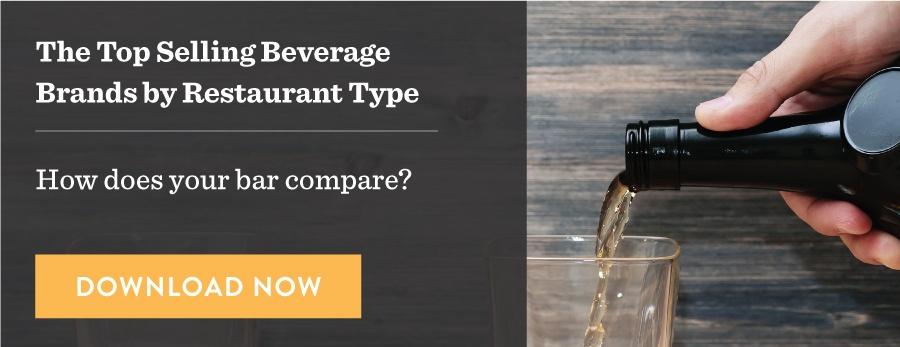
How to Build a Cocktail Bible
Here’s everything you need for an effective house cocktail bible.
So, you’ve decided to sit down and chronicle all of your bar’s cocktails, so that they may stand the test of time and your rookie bartender’s brain. But, where to begin? And what exactly do you need to include to make your establishment’s cocktail bible truly useful for you and your staff?
Let’s run down everything a great cocktail bible should feature.
Organized and Standardized Recipes
This will seem like a no-brainer for some, but the more unorganized the cocktail recipes in your bible are, the more likely errors will occur in your bartender’s memory. Following the same patterns throughout your cocktail bible, whether it be measuring formats, the order of spirits and even the order of cocktails, will go leaps and bounds into creating lasting mental impressions for your bartenders.
If you’re struggling to generate a format for your recipes, it can go something like this:
Old Fashioned
- 1.5 oz Bulleit Rye
- 2 dashes Angostura bitters
- 1 sugar cube
- 3 dashes plain water
Muddle sugar, bitters, water in Old Fashioned glass. Fill with ice cubes. Add whiskey. Garnish with orange peel.
Measuring everything in a specific number of ounces and dashes and organizing cocktails around base spirits are great standard practices to optimize your bible.
Includes Cocktails That Aren’t On Your Menu
It can be really easy to only cover the cocktails featured on your menu and be done with it. We understand that hammering out recipes for all of the classic cocktails might seem like a towering task when you have a million other things on your plate. But, not every person will stick to the confines of your menu. There will be people asking for cocktails they will expect your bar staff to know.
If you don’t want your less-experienced bartenders to pull random recipes from their smartphones, having off-menu cocktails in your bible is the only way to reasonably guarantee the same cocktail every time. We recommend the IBA (International Bartenders Association)’s Unforgettables and Contemporary Classics lists as great launching points.
Easily Accessible To Your Staff At All Times
We’re all human. There are going to be those moments when you just can’t for the life of you remember the exact ingredients of a Toronto. (Rye, Fernet, simple, bitters, orange peel garnish, FYI.)
Instead of forcing you and your bartenders to struggle to recall on the fly, it can be life-saving to have a dedicated printed copy of your bible tucked away in a discreet corner of the bar for those brain fart emergencies. Hosting your cocktail bible on a cloud-based digital system like Google Drive can also make you and your bartender’s lives that much easier, especially if you’re already using an iPad to host your POS system and bar management technology.
If you thought this was helpful in better managing your cocktail program, feel free to check out our free resources like the Drink Price Calculator. Also, let us know which essential cocktails you think need to be covered in a cocktail bible in the comments section below.

Schedule 15mins to chat with a product specialist
Start a FREE Trial Today! BevSpot offers full product education and account setup for all customers! No card Information needed!
